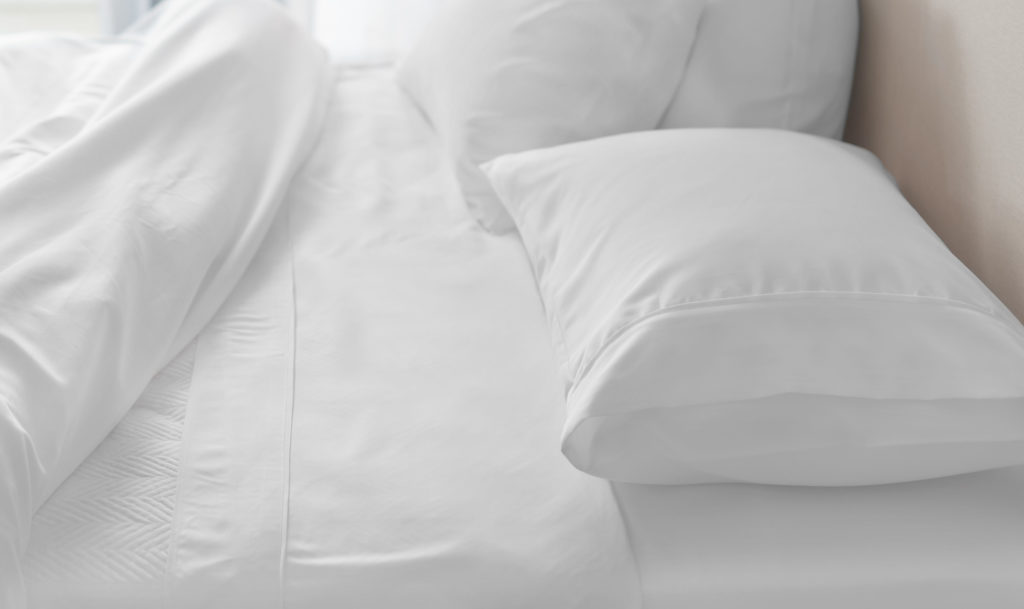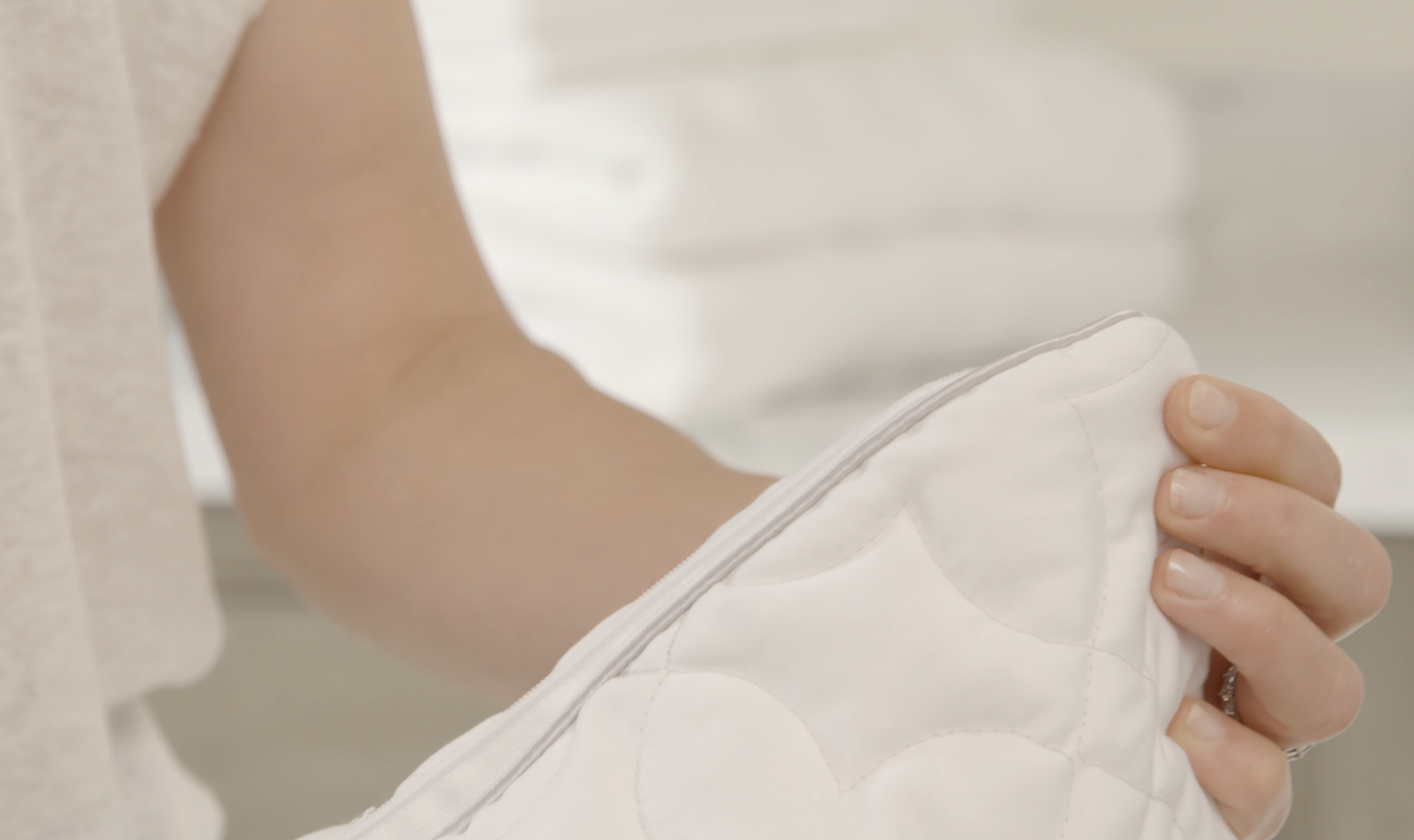Nothing starts your day off on a positive note more than getting a good night's sleep. And nothing facilitates a good night's sleep more than the right pillow. Pillows can not only impact the quality of our sleep, but also how healthfully we rest and recharge. Here are a few questions to ask yourself before choosing the perfect pillow.
Do You Like a Soft or Firm Bed Pillow?
The "loft" of a bed pillow is determined by the volume of fill it contains. For a firm pillow, the fill will be tighter. For a soft pillow, the fill will be lighter. Prepare to renovate the feather or down fill every 10 years or so, regardless of the firmness. Synthetic fibers can be used to create any level of firmness. Front sleepers need to minimize neck strain so down or super soft synthetic fibers will be all you need for undisturbed slumber. Back sleepers are most comfortable with shoulder support, so the medium firmness given by mixed feather and down or medium synthetic blends are ideal.
What Size Will You Need?
To choose the right size pillow, you'll need to consider three factors: how big your bed is, how many pillows you need and how you will use them. Pillow sizes correspond roughly to mattresses (standard, queen, king). The size of bed pillow you pick will depend on the size of your bed and how you sleep.
 The goal when choosing a pillow is to keep your head in “neutral alignment,” similar in position to how you’d look standing up with good posture.
How Big is Your Bed?
For a twin bed, you'll most likely choose the standard size and for a queen bed you'd want to get two queens or two standards. For a king bed you'd get two king pillows or four standards. If you prefer a large pillow to snuggle with on a smaller bed, use a king on a twin bed. If you want a stack of large pillows to lean on, choose as many as is comfortable to you. You could easily choose 4 or 6 standard pillows for a king size bed. Luxury hotels use 4 kings on a queen bed. The choice is yours and depends on what you feel comfortable with.
Do You Sleep on Your Back, Your Side, or Your Stomach?
The way you sleep will affect the loft, or height, of your pillow and different positions require different types of support. The goal is to help keep your head in what is called a 'neutral alignment,' meaning your head is sitting squarely on your shoulders without bending back too far or reaching too far forward. Most quality pillows give information about the best use for the type of pillow you're considering. Try out several variations to find what works for you.
The goal when choosing a pillow is to keep your head in “neutral alignment,” similar in position to how you’d look standing up with good posture.
How Big is Your Bed?
For a twin bed, you'll most likely choose the standard size and for a queen bed you'd want to get two queens or two standards. For a king bed you'd get two king pillows or four standards. If you prefer a large pillow to snuggle with on a smaller bed, use a king on a twin bed. If you want a stack of large pillows to lean on, choose as many as is comfortable to you. You could easily choose 4 or 6 standard pillows for a king size bed. Luxury hotels use 4 kings on a queen bed. The choice is yours and depends on what you feel comfortable with.
Do You Sleep on Your Back, Your Side, or Your Stomach?
The way you sleep will affect the loft, or height, of your pillow and different positions require different types of support. The goal is to help keep your head in what is called a 'neutral alignment,' meaning your head is sitting squarely on your shoulders without bending back too far or reaching too far forward. Most quality pillows give information about the best use for the type of pillow you're considering. Try out several variations to find what works for you.
 Pillow protectors can help extend the life of your pillow. You can test if a pillow is ‘dead’ by seeing if it springs back after you fold it in half. If it doesn’t spring back, it’s time to get a new one.
Do You Know How to Care for Your Pillow?
Pillow protectors can help extend the life of your pillow. You can test if a pillow is ‘dead’ by seeing if it springs back after you fold it in half. If it doesn’t spring back, it’s time to get a new one.
Do You Know How to Care for Your Pillow?
 The goal when choosing a pillow is to keep your head in “neutral alignment,” similar in position to how you’d look standing up with good posture.
The goal when choosing a pillow is to keep your head in “neutral alignment,” similar in position to how you’d look standing up with good posture.- If you sleep on your back: Back sleepers need less support, so their head is not thrown too far forward. Look for one with extra loft in the bottom third to cradle your neck.
- If you sleep on your side: Side sleepers need a firmer fill to support the distance between the ear and outside shoulder while still maintaining comfort.
- If you're a stomach sleeper: Look for a very thin, almost flat pillow. You may find you don't need one for your head, however consider tucking one under your stomach to avoid lower back pain.
 Pillow protectors can help extend the life of your pillow. You can test if a pillow is ‘dead’ by seeing if it springs back after you fold it in half. If it doesn’t spring back, it’s time to get a new one.
Pillow protectors can help extend the life of your pillow. You can test if a pillow is ‘dead’ by seeing if it springs back after you fold it in half. If it doesn’t spring back, it’s time to get a new one.- The general rule is to buy a pillow every 12 to 18 months. After two years, it's definitely time to replace.
- It's important to clean a bed pillow regularly. A quality purchase will come with care instructions. You may wash some feather and down stuffing in a home washer while others should be dry cleaned. Save the cleaning instructions and follow them to ensure a long life.
- Dry and then air your bedding thoroughly before returning it to your bed. Synthetic fibers will dry quickly and are relatively wrinkle-free.
Tags:
